Review of Modern Tendencies DOOH and DON in 2012-2013 - Part 2
The current article is based on the report of Dr. Krylov at the Conference “DigitalOOH: interactive communication with consumers” that was organized by Outdoor media Magazine and its Chief Editor Andrey Galkin - www.outdoor.ru
5. Implementation of new technologies of secure broadcasting and secure log reports (customers no longer receive photo reports but extensive digital reports of actual campaign conducted)
This tendency is directly related to the latest IT achievements and to the ever increasing number of hacking attacks on digital advertising carriers:
First experiments in this area started way back in 1998 in Russia and the USA almost simultaneously. Another 10 years passed with no major changes, when finally from 2011 commercial solutions in the area of secure network broadcasting found their way to the market and are currently being implemented on a wide scale.
Modern digital technology started using EDS (electronic digital signature) to ensure protected (against hacking and substitution of content) channel during broadcasting on both outdoor (LED) and indoor (LCD) displays. During broadcast specialized log files are generated recording the time of displaying each commercial, signature of the person who authorized the broadcast and inserted this particular commercial into the broadcast schedule.
 |
 |
| The Unified Control Center for digital screens that monitors performance of the equipment and compiles secure log files for customers | |
6. Innovative forms of digital messaging and video presentations of outdoor advertising, including interactive methods of attracting customers
Interactive digital messaging is directly related to innovations in informational technologies. First interactive systems appeared in the USA, Japan and Europe and are closely related to current trends in developing urban spaces.
 |
 |
| Interactive informational and advertising complex for public transport: busses and taxis (New York, Hong Kong, Guanzhou, Beijing) | Interactive informational systems for urban spaces – Hong Kong, Beijing: interactive regime is only activated when people are located close to the screen. At other times the screen automatically reverts to standard advertising mode of operation. |
7. Informational support to public events in political, social or legal spheres, including local news and PA reporting in various formats
This tendency became evident together with the appearance of the first digital advertising networks in 1990-ies. The authorities in the USA, England and China became aware of the potential of digital outdoor networks for public purposes. In Russia this started in 2001 on a small scale when the annual interactive interviews with the nation of the then Russian President Vladimir Putin were displayed not only on TV but on outdoor LED screens located around the country. Since then such annual TV-bridge interviews became regular features on Russian streets and squares.
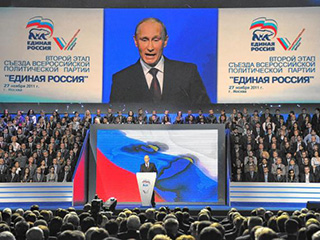 |
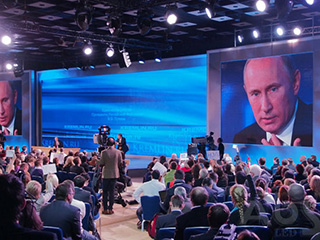 |
| President Vladimir Putin’s address to the “Jedinaya Rossija” Party Congress in November 2011 – live broadcast Photo credit: nydailynews.com |
LED screens at the press conference of the President Vladimir Putin in December 2012 Photo credit: szabsen.com |
Moreover, the Russian Ministry of Emergency Situations developed an “Oksion” PA (public address) Program that is using various digital OOH informational channels (including digital LED Networks) for reaching the absolute majority of urban population in the event of emergency – and selling commercial advertising in normal times.

Joint Program between the Ministry of Emergency Situations in St-Petersburg and a commercial LED screen
network focused on informational reach to city population. Part of the advertising time is provided
to the Ministry and LED screens display essential political, social
and administrative messages throughout the city.
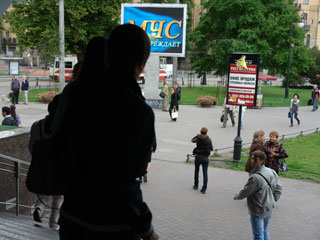 |
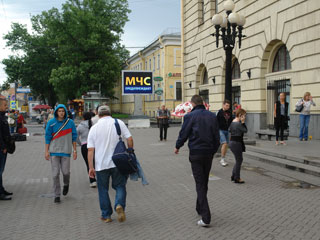 |
| Informational support of city events at LED screens of AstraVision commercial Network. Pilot project of city PA Program using outdoor LED screens – all screens are using secure broadcast channels and EDS (St-Petersburg - 01.08.2012) |
|
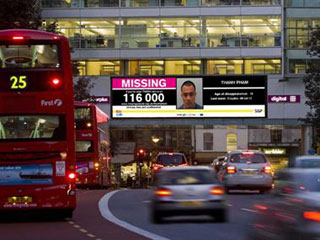 |
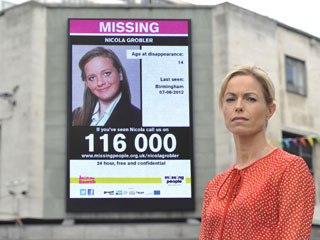 |
| Missing person search messages on LED screens | |
This is our future!
The future of both indoor and outdoor advertising lies exclusively in the area of digital technologies. All screens will be merged in digital networks that are gradually turning OOH messaging into a new channel of mass media. All screen networks will serve as part of the OOH informational media related to and controlled by the authorities.
Since we live in the digital age, all advertising around us will be digital and dynamic. This tendency is inevitable and stable and supported by the fast progress in the area of digital technologies. The screens are getting better in quality. They are energy efficient, ecologically friendly and reliable. Nowadays they are becoming also socially oriented.
Main terms
Digital Out Of Home (DOOH) - Digital systems installed outside of home. Initially the term DOOH described only indoor LCD monitors (railways, supermarkets etc.) or transport systems (busses and taxis). However lately the term is used loosely to cover both indoor and outdoor (street-placed) urban systems.
Digital outdoor network (DON) - Initially, the concept conceived by Clear Channel to describe their own outdoor network controlled from the Unified control center.
Outdoor TV - digital outdoor screen networks with a wide range of functions and the possibility of TV-type real time live broadcasting of any content, including social, informational or advertising commercial content.
Public TV - networks of digital out-of-home systems located in public spaces both indoor and outdoor.
Secure broadcasting - broadcasting only of the authorized content (countersigned with the electronic digital signature EDS – i.e. a broadcast protected from any possibility of hostile content substitution.
Secure reports - EDS-secured reports to clients about actual broadcasting on LED screens that are restricted in access to any hostile attempt at tempering both from hackers and insider operators.





